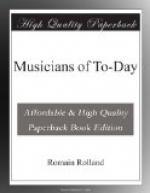[Footnote 213: This is according to M. Rivet’s report on the Beaux-Arts in 1906. The Opera employs 1370 people, and its expenses are about 3,988,000 francs. The annual grant of the State comes to about 800,000 francs.]
[Footnote 214: On the occasion of the revival of Don Juan in 1902, the Revue Musicale counted up the pages that had been added to the original score. They came to two hundred and twenty-eight.]
In spite of the changes of taste and the campaign of the press, the Opera has remained to this day as it was in the time of Meyerbeer and Gounod and their disciples. But it would be foolish to pretend that it has not its public. The receipts show well enough that Faust is in greater favour than Siegfried or Tristan, not to speak of the more recent works of the new French school, which cannot be acclimatised there.
Without doubt, the enormous stage at the Opera does not lend itself well to modern musical dramas, which are intimate and concentrated, and would be lost in its immense space, which is more adapted for formal processions like the marches in the Prophete and Aida. Besides this, there is the conventional acting of the majority of the singers, the dull lifelessness of the choruses, the defective acoustics, and the exaggerated utterance and gestures of the actors, demanded by the great dimensions of the place—all of which is a serious obstacle to the conception of a living and simple art. But the chief obstacle will always lie in the very nature of such a theatre—a theatre of luxury and vanity, created for a set of snobs, whose least interest is the music, who have not enough intellect to create a fashion, but who servilely follow every fashion after it is thirty years old. Such a theatre no longer counts in the history of French music; and its next directors will need a vast amount of ingenuity and energy to get a semblance of life into such a dead colossus.




